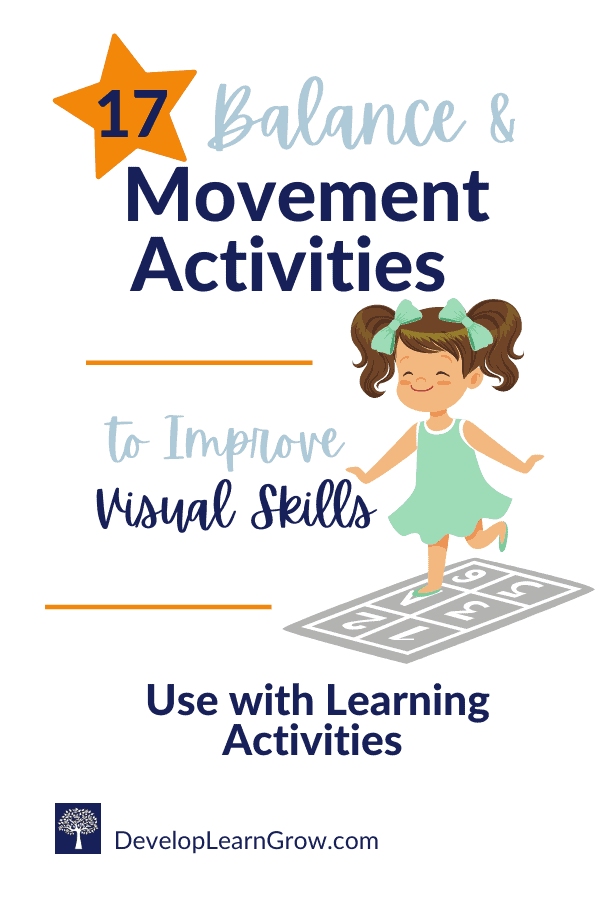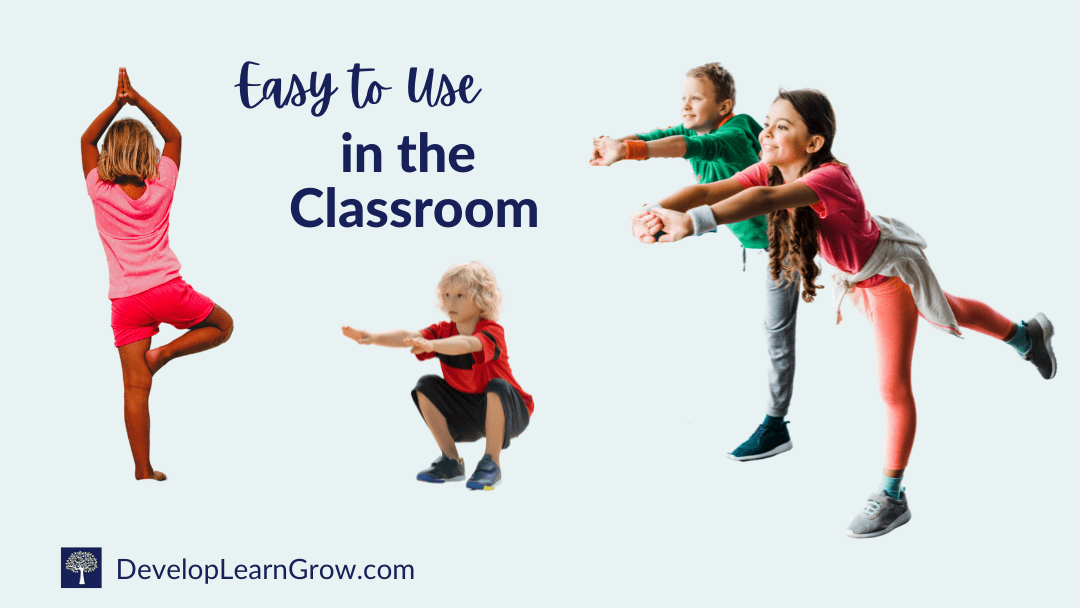Specific movement activities and balance activities help improve visual skills in kids. The brain’s movement system and the visual system work together for reading and learning.
A child learns using the whole brain. Information to the lower parts of the brain from movement input allows higher areas to be accessed and used for adequate learning.
Movement is so essential for a child’s brain development. It provides a strong foundation that supports core stability, muscle development and eye muscle control.
No matter what a child’s occupational therapy goal may be for me, movement is always a part of the treatment plan.
Whether I work with teenagers, elementary kids, preschoolers, or younger children, I always incorporate movement!
Movement activities for kids are essential for learning and reading.
Vestibular Movement Activities Improve Visual Skills for Reading and Learning
The movement and balance system is known as the vestibular system. The vestibular system is the director of the nervous system.
It’s one of the important sensory system building blocks on the pyramid of learning.
Your brain processes movement input and gives you information about gravity, position in space and balance.
Because of this system, you’re able to automatically keep your head in an upright position in the middle of your body when moving around.
The vestibular system and visual systems work very closely together in the brain. They rapidly process movement input and make adjustments to body muscles and eye muscles.
The vestibular system supports core stability and posture and it controls the movements of the eyes.
Your oculomotor skills develop based on movement input.
For example, proper posture and a consistent neutral, upright head position allow your eyes to take in visual information evenly and correctly.
The brain’s ability to take in and process the visual input is supported with opportunities for movement and good muscle tone and posture.
You’re able to focus on an object with your eye muscles while also moving your head or your body. Additionally, you can use efficient eye movements during visual scanning.
Babies who have issues with their necks or flattened heads on one side end up with a tilted head. The eye muscles automatically adjust to the tilted head position and become misaligned when the head is in neutral. Eye teaming becomes difficult (the eyes have a hard time working together) and double vision can occur.
It’s so important to focus on movement, balance, and posture to support visual skills.
Why Incorporate Movement Activities to Improve Visual Skills into Your Learning Routines?
Piaget, Child Development Psychologist said it best: “We must perceive in order to move, but we must move in order to perceive.”
Movement and balance input are a crucial part of the central nervous system’s foundation for learning. (See the Sensory Pyramid of Learning.)
Movement opportunities improve body awareness and perception. The more children move through space and use their vestibular system, the more their movements become more automatic for daily tasks.
In addition, processing movement input helps with self-regulation and attention.

Children develop in a normal sequence. A child must process input in the lower parts of the brain through movement and sensory experiences before they can access and use higher parts of their brains for learning.
Developing gross motor skills using the larger muscles helps develop visual motor skills and fine motor skills.
Moreover, children develop good visual perceptual skills with movement experiences and when interacting with objects in the environment. Visual perception skills such as visual discrimination are important for identifying and learning letters.
[The post 15 Important Occupational Therapy Visual Skills Activities shares more details about the visual system and how visual activities support reading. Also, 42 Easy Visual Perceptual Activities That Enhance Learning shares activities that support all visual perception skills areas.]
Kids need to incorporate balance and movement activities every day as part of their play and learning routines. Check out these 17 easy and fun ways to add movement to your day.
17 Examples of Balance & Movement Activities to Improve Visual Skills
The movement activities listed below are quick and easy to add to your daily activities. They’re categorized into simple balance activities, movement and balance activities, head movement exercises, and visual tracking activities.
Add them during a transition, before a lesson, to a learning center, morning activities, or indoor recess.
Many exercises listed below can be used with a partner which are a great way to encourage social interaction.
Add these movement activities during daily tasks and as a brief brain break before a lesson. Get your kids to stand up and move routinely!
SIMPLE BALANCE ACTIVITIES
These easy balance activities are a great way to introduce simple activities for the vestibular system. These simple and basic movement activities support the strength and control of the eye muscles.
1) Balance on Tip Toes
This is a simple way to stimulate the balance and visual systems. Start with 3 seconds and work up to 10 seconds or more.
Kids can also hold their thumb out in front of them and stare at it to work on visual attention. Or they can watch it as they slowly move it back and forth to the sides to work on visual tracking of a moving target.
2) Rock Back and Forth on Feet
Heel to toe rocking is another easy way to work on balance.
Once kids gain control and get into a rhythm, they can extend straight arms to the sides and scissor them in front of their bodies. (Arms straight out to the sides, cross in front. Back to the sides and cross again in front, opposite arm on top.)
3) Balance Beam and Line Walking
Use lines on the carpet or tile or place tape on the floor. Have kids walk heel to toe along the line.
For an added challenge, they can focus on a visual target on the wall as they move along (add letters, sight words, or spelling words.)
4) Tap Feet on the Ground
A leader models rhythmical tapping of the feet (while standing) at various patterns and speeds (3 right-3 left, 3R-1L, 1R-3L, etc.) Make sure children do not hold onto a chair or furniture.
Start with a toe tap and then practice lifting the leg and tapping out in front of the body. For extra challenges, use a metronome to follow a beat or add clapping hands.
5) Stand on One Leg
Balancing activities are a great way to stimulate the vestibular system and the eye muscles. Balance on each leg for 5-10 seconds. Close the eyes as an added challenge.
For added visual attention and concentration, look at a clock on the wall while balancing and say numbers 1-12 as they look at each number.
Older children can visualize a clock in front of them and move their eyes in a circle according to the positions of the numbers. They can also hold up a finger or thumb if needed.
MOVEMENT AND BALANCE ACTIVITIES
Children develop visual motor integration when they participate in gross motor movement and balance activities.
More practice with coordinating larger muscles helps with eye-hand coordination and the development of fine motor skills. These activities also support the control of the eye muscles.
6) Jump Softly
Jump forward and backward over a line on the floor (or ruler, pencil, eraser, jump rope.) Really challenge kids with this one by having them close the eyes! Count with each jump or recite the alphabet.
7) Hop on One Leg
Hop forward then backward on each foot. Follow a leader’s directions (right leg 3 hops forward-2 hops back, left leg 2 forward-3 back.)
8) Spin Around
Students choose a visual target at least 5 feet away from them. They spin around and try to find and refocus on their target. Spins should start slowly and increase in speed as they gain motor control.
9) Jump Side to Side
A visual line of tape, chalk on a carpet, or a flat object can be placed on the floor. Start jumping side to side. Kids can count forward and backward as they jump.
To add crossing the midline of the body, kids can clasp hands together and bring them from the center of the body to the opposite hip in the different direction of the feet as they jump.
10) Jump onto Targets
This is an easy exercise activity to add to a location that’s frequently used (on the way out the door, in the hall, on the way to the bathroom, etc.)
Tape can be placed on the floor or you can use rubber non-slip spotters. I’ve borrowed them from phys ed teachers, or I’ve made my own from drawer liner or Dycem.
With my homemade versions, I often draw different letters or numbers on them so that children can recite them as they jump.
HEAD MOVEMENT EXERCISES TO IMPROVE VISUAL SKILLS
Moving the head in different directions stimulates the various canals in the vestibular system. Stimulating the different canals increases attention and focus in the brain and nervous system.
11) Windmills
Stand with feet wider than shoulder width. Arms are held straight to the sides. Bend at the hips (keep legs straight) and touch opposite hand to opposite foot. Return to standing and repeat on the other side. Do 6-10 touches.
12) Toe Touches
Reach down and touch toes, pause at the bottom. When kids return to a standing position, they can look at a target or chart and read a sequence of letters or words. Students can pair up for this activity to read a chart or read rotating cards held by the partner.
13) Head and Neck Movements
The leader calls out directions, or kids pair up with a partner and mirror the partner’s movements. For example, right ear to right shoulder, look down, look to the left, left ear to left shoulder, look up, look to the right, etc.
14) Side to Side Sways
Hands on hips, feet still, and bend side to side. Vary the speed of the side bends. Focus on a fixed stationary target to strengthen the eye muscles.
VISUAL TRACKING ACTIVITIES
Visual tracking activities are great eye exercises for kids that they need for reading and daily tasks. Add a balance or movement activity as an added challenge.
15) Infinity Loop
Imagine a number 8 laying on its side. Trace the loop in the air. Start in the center and go up to the left and continue around several times. Switch hands, use pointer fingers or thumbs.
This is an excellent exercise for kids! See Visual Tracking Activities Using the Infinity Loop for more ideas. It shares how to use it with several learning activities.

16) Bean Bag or Ball Tosses
Pair motor actions with learning. Use bean bags or balls with letters, numbers or words to help with hand-eye coordination.
Toss up in the air and catch to recite what’s on the bag or ball. Or use during partner pair ups.
17) Bounce a Ball, Catch and Spell or Move
Use a tennis ball, bounce, catch and sequence spelling words one letter at a time (with each bounce and catch.)
Practice directional words by stepping in various directions (forward, back, right, left) after catching the moving ball. These can be verbalized from a partner or written on a poster on the wall.
These 17 common activities can really help your younger and older children improve movement processing, balance and visual skills.
If some of your students need more support with balance, they may need more postural and core activities. A strong core is needed to help with balance. Check out 40 Core Exercises for Kids for additional activities (and a free printable.) Several exercises listed above also suggest adding crossing the midline of the body with the arms. Click this link for more midline crossing activities that help the two sides of the brain communicate together.
Tips When Trying the Movement & Balance Activities
As an occupational therapist, I often work with kids with vestibular difficulties and problems with visual processing skills. The activities shared in this post are basic activities that can be used with all kids.
However, with any physical exercises, caution should be taken for each individual student. Firstly, and obviously, make sure kids are being safe when practicing the activities.
When performing the exercises, make sure you have enough room around each child.
Check for objects on the floor that could cause one to slip. Make sure furniture or objects are far enough away in case of a loss of balance.
Emphasize a rule that all children must use good motor control. I tend to have to frequently emphasize “be in control of your body” to large groups.
Start with easier activities and gradually add the challenges when the kids are ready.
Finally, as stated in the disclaimer, the activities listed in this post are informational, not therapeutic. See the full disclaimer for more information.
Related Posts with Movement Activities
- 43 Occupational Therapy Motor Coordination Activities
- 61 Fun Gross Motor Activities for Elementary Indoor Recess
- Top Skill Building Outdoor Games for Kids at School
- 30 Fun Movement Activities and Ideas for Elementary Kids
Additional Movement Activities and FREE Downloadable PDF Handouts for You
The Best Brain Breaks post has a free printable that includes six of these exercises on a one page handout. It contains a sequence of 8 exercises that activate all areas of the brain (with 13 total steps.) The entire sequence can be completed in less than 2 minutes! Click the previous link for more info or the button below for quick access to the PDF:
If you’d like more activities for reading and writing skills, check out How to Improve Reading Skills with 50+ Sensory Strategies. It lists balance and crossing midline activities, as well as visual and auditory activities for kids. Click the previous link for more info or the button below for quick access to the PDF:
Do Your Students Need a Fun Challenge for Their Bodies and Brains?
Use these specific occupational therapy exercises to improve:
Attention… focus… core stability… crossing midline… sensory processing… visual development… & more… Click for more info!




0 Comments